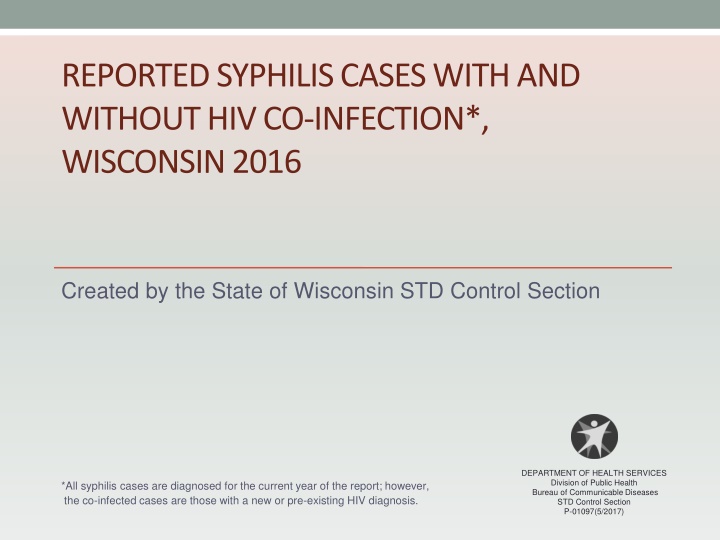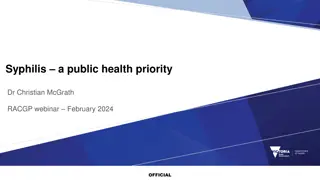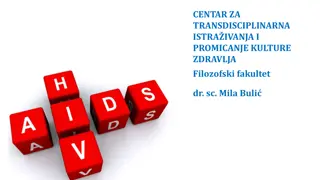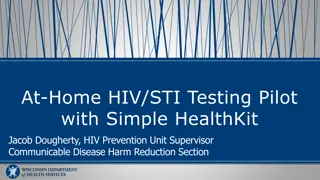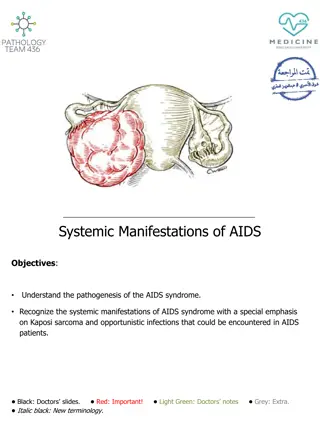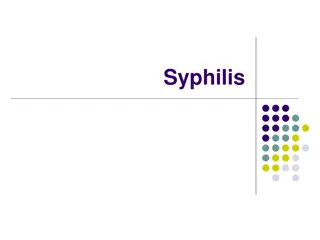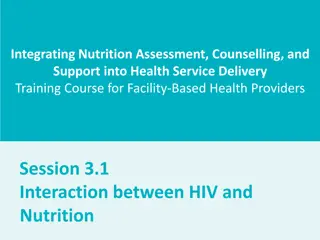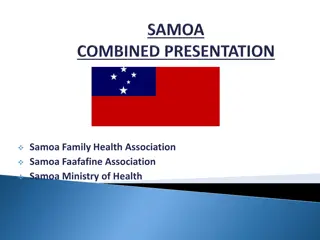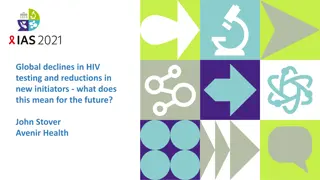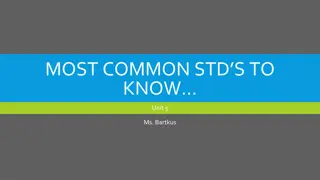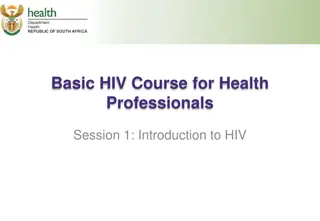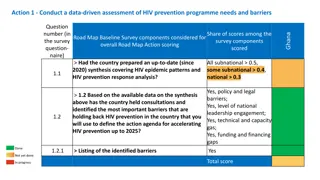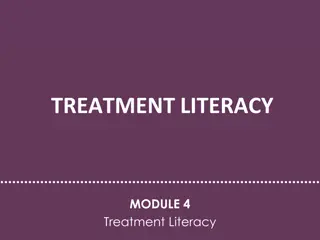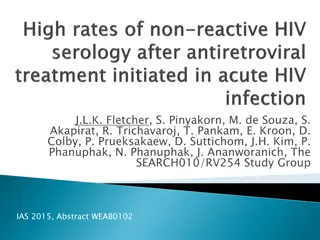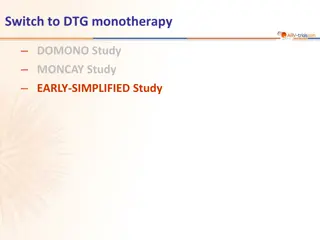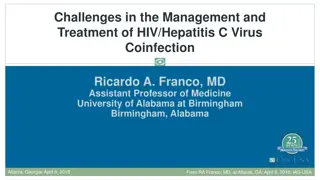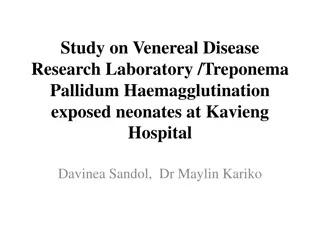Syphilis Cases with HIV Co-Infection in Wisconsin 2016
The report details syphilis cases with and without HIV co-infection in Wisconsin for 2016, showing a high proportion of co-infection among men and age group variations.
Download Presentation

Please find below an Image/Link to download the presentation.
The content on the website is provided AS IS for your information and personal use only. It may not be sold, licensed, or shared on other websites without obtaining consent from the author.If you encounter any issues during the download, it is possible that the publisher has removed the file from their server.
You are allowed to download the files provided on this website for personal or commercial use, subject to the condition that they are used lawfully. All files are the property of their respective owners.
The content on the website is provided AS IS for your information and personal use only. It may not be sold, licensed, or shared on other websites without obtaining consent from the author.
E N D
Presentation Transcript
REPORTED SYPHILIS CASES WITH AND WITHOUT HIV CO-INFECTION*, WISCONSIN 2016 Created by the State of Wisconsin STD Control Section DEPARTMENT OF HEALTH SERVICES Division of Public Health Bureau of Communicable Diseases STD Control Section P-01097(5/2017) *All syphilis cases are diagnosed for the current year of the report; however, the co-infected cases are those with a new or pre-existing HIV diagnosis.
Reported syphilis cases with and without HIV co-infection, Wisconsin 2016 Proportion of syphilis vs. syphilis/HIV co-infected cases Syphilis Cases with and without HIV Co-Infection Syphilis- HIV 34% Syphilis-Only 283 Syphilis-HIV 144 Syphilis- Only 66% TOTAL Cases 427 Syphilis in Wisconsin has a high proportion of co-infection with HIV. The number of cases has increased dramatically from 2015 (95 co infected cases in 2015 vs. 144 in 2016). The percentage of co-infected cases to cases not co-infected has remained relatively the same (35/65% for 2015 vs. 34/66% in 2016). The cases in this report that are co-infected with HIV may or may not have contracted HIV in 2015. Some people who were co-infected may have found out about their HIV diagnosis at the same time as their syphilis diagnosis, while others had a pre-existing HIV diagnosis for years and became recently infected with syphilis.
Reported syphilis cases by sex in Wisconsin, 2016 400 350 300 250 200 CASES 150 100 50 0 Male 141 226 367 Female 1 55 56 Transgender 2 2 4 Syph/HIV Syphilis-Only Syphilis Most syphilis cases in Wisconsin occur among men. Out of the 427 total syphilis cases, 367 of them occurred among men, 56 occurred among women, and 4 cases were among transgender. Of the syphilis-only cases, 226 occurred among men, 55 occurred among women and 2 cases were transgender. However, the cases of syphilis/HIV co- infection show an even greater proportion of men being infected (141 men, 1 woman and 2 transgender). This unusually high proportion of men being infected is an indication of a high number cases which are men having sex with men (MSM).
Proportion of syphilis cases that are HIV co-infected to syphilis-only cases within each age group 80 50.0% 45.0% 70 40.0% 60 35.0% 50 30.0% 40 25.0% 20.0% 30 15.0% 20 10.0% 10 5.0% 0 0.0% Age Group 10-14 0 2 0.0% 15-19 2 16 11.1% 20-24 21 69 23.3% 25-29 33 44 37.9% 30-34 23 31 42.6% 35-39 18 23 43.9% 40-44 14 21 40.0% 45-49 16 18 47.1% 50+ 18 48 27.3% Syph/HIV Syphilis-Only Proportion The proportion of syphilis-only cases compared with the number of syphilis/HIV co- infected cases varies across age groups. The age groups on the bottom row of the chart are Centers for Disease Control and Prevention (CDC) recommended age group distributions. This year we have seen a greater proportion of syphilis cases co-infected with HIV among age groups from 35-49. In 2015, the percentage for 35-49-year-olds was 32.5% but jumped up to 43.6% for 2016.
Reported syphilis-only and syphilis/HIV co-infections by race/ethnicity in Wisconsin Proportion of syphilis-only cases in Wisconsin, 2016 Proportion of syphilis/HIV co-infected cases in Wisconsin, 2016 Proportion of race/ethnicity in Wisconsin, 2015 0% 3% 0% 0% 3% 0% 1% 1% 0% 0% White 7% White 9% 7% Afr. Amer. 6% White Afr. Amer. Hispanic Hispanic Hispanic 47% 46% Amer. Indian Afr. Amer. Amer. Indian Asian/Pac. Is. 41% Amer. Indian Asian/Pac. Is. 46% 83% Other (Mult.) Asian/Pac. Is. Other (Mult.) Unknown Unknown 2015 cases among white non-Hispanics made up the majority of cases. However, in 2016 African Americans made up 41% of the syphilis/HIV co-infected cases and 46% of the syphilis-only cases in Wisconsin, while African Americans only make up 7% of the population in Wisconsin compared to 83% White. This racial disparity primarily occurs in the southeastern part of Wisconsin, specifically in Milwaukee. The 2015 census data was the most recent data available.
Reported cases of syphilis-only, syphilis/HIV co-infections and total syphilis cases for the five regions of Wisconsin, 2016 300 250 200 CASES 150 100 50 0 Northeastern 14 43 57 Northern 1 8 9 Southeastern 100 153 253 Southern 21 60 81 Western 8 19 27 Syphilis/HIV Syphilis Only Total Syphilis The largest number of cases in Wisconsin among the five regions occurred in the southeastern region. The southeastern region had 253 total cases of syphilis, which was 59.3% of all the syphilis cases in Wisconsin. This region also had 100 cases of syphilis/HIV co-infections, which was 69.4% of all the syphilis/HIV co-infections in the state. This represents a decrease: In 2015 the southeastern region currently made up 67.8% of all cases and 74.7% of co-infections. The southeastern region makes up just 36.8% of the population in Wisconsin.
Syphilis stages among syphilis/HIV co-infections, Wisconsin 2016 Syphilis stages among syphilis cases, Wisconsin 2016 Primary syphilis Primary syphilis 8% 9% 21% 31% Secondary syphilis Early latent syphilis Late syphilis Secondary syphilis Early latent syphilis Late syphilis 23% 23% 47% 38% Early syphilis (infected with syphilis less than one year) occurs among the primary stage, the secondary stage and the early latent stage. Late syphilis occurs after one year of being infected. For people who are HIV positive, it is better to be diagnosed with early syphilis rather than late syphilis. People who are HIV positive and have late syphilis are usually required to have a central spinal fluid test to rule out neurosyphilis. In 2015, 18% (17/95) of the syphilis/HIV co-infections were diagnosed with late syphilis. In 2016, 21% (30/144) of the syphilis/HIV co-infections were diagnosed with late syphilis which means we must continue to make sure HIV care providers are testing their patients on an annual basis. Unfortunately, people who are co-infected with syphilis/HIV who are not in care or find out about their co-infections at the same time are more likely to be in the late stage of syphilis. The Wisconsin STD Section, per the CDC, recommends that all HIV positive patients and all men who have sex with men receive an annual syphilis test to prevent late latent syphilis.
Syphilis and syphilis/HIV co-infections among men who have sex with men in Wisconsin, 2016 Reported Syphilis Cases in Wisconsin, 2016 (n=427) Reported Syphilis/HIV co- infected cases in Wisconsin, 2016 (n=144) Men who have sex w/men (MSM) Non-MSM 32% Men who have sex w/men (MSM) Non-MSM 68% 95% One of the groups at highest risk for syphilis and syphilis/HIV co-infections is men who have sex with men, (MSM). This includes not only people that identify as gay, but also others that identify as bi-sexual, or straight, as well as some transgender. This is a self- reported risk factor, which means that these individuals were interviewed and reported themselves as MSM either to a provider or to a disease intervention specialist (DIS). In 2016, among all the syphilis cases, 289 of the 427 cases reported that they were MSM, which made up 68% of the syphilis cases in Wisconsin. This is similar to 2015, however, in 2016, 137 out of 144 co-infected cases reported being MSM, which is 95.1% of cases.
Reported syphilis/HIV co-infection, syphilis-only and total syphilis cases in Wisconsin, 2012 - 2016 450 400 350 300 CASES 250 200 150 100 50 0 2012 67 172 239 2013 71 176 247 2014 101 178 279 2015 95 175 270 2016 144 283 427 Syphilis/HIV Syphilis-Only Total Syphilis Over the years there has been a steady increase in the number of syphilis-only, syphilis/HIV co-infected, and total syphilis cases. In 2012, the total number of syphilis cases was 239 and the number of syphilis/HIV cases was 67. In four years, the number of syphilis cases rose to 427 for a 56% increase and the number of syphilis/HIV co- infected cases rose to 144 for a 47% increase. This was after a small decline in 2015. The 2016 overall syphilis numbers increase 63% and syphilis/HIV co-infections increase 66% from 2015.
Proportion of previous and newly diagnosed HIV cases among 2016 syphilis and HIV co-infections, n=144 17% Previous HIV+ Newly Dx HIV+ 83% The number of syphilis and HIV co-infections was 144. The number of these cases that were diagnosed with HIV previous to their syphilis infection was 119. The number of cases that were diagnosed with syphilis at or around the same time as they were diagnosed with HIV were 25. Of the cases that were newly diagnosed with HIV and syphilis at the same time, 14 were considered late syphilis (a total of 30 late syphilis and HIV co-infections). This means that 16 cases were already known to be infected with HIV and late syphilis (they did not receive a syphilis test in the year previous to their diagnosis). The Division of Public Health will continue to remind HIV care providers about the need to ensure all HIV positive individuals receive a yearly syphilis test.
Questions? Please Contact: Brandon Kufalk, Public Health Educator State of Wisconsin STD Control Section Division of Public Health Department of Health Services Phone 608-261-6390 or email Brandon.Kufalk@wisconsin.gov Note: All population data was queried using Wisconsin Interactive Statistics on Health (WISH) which can be found at: https://www.dhs.wisconsin.gov/wish/index.htm
